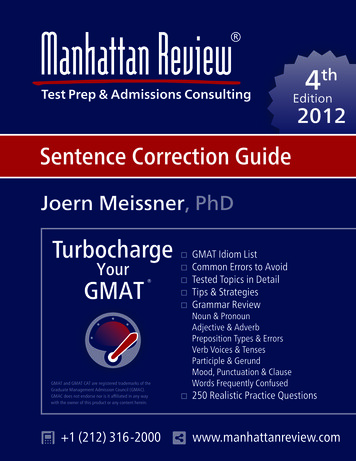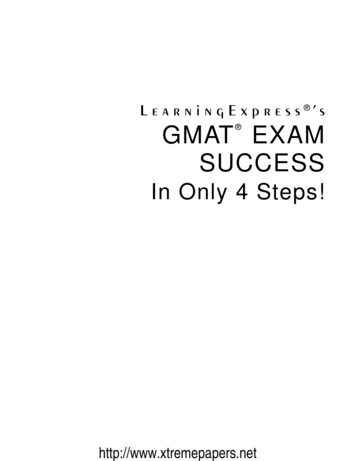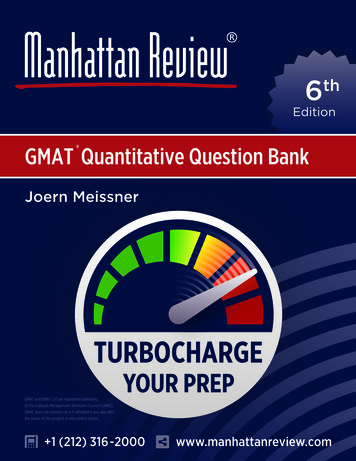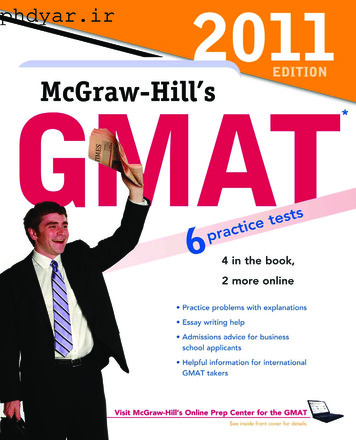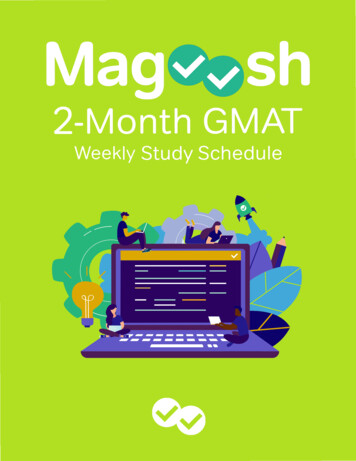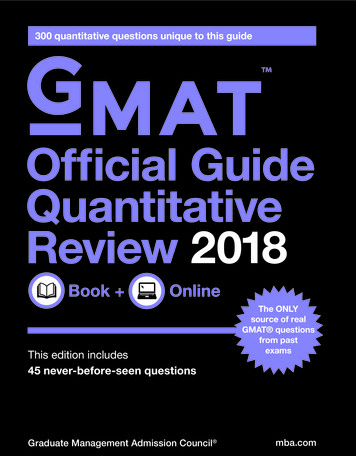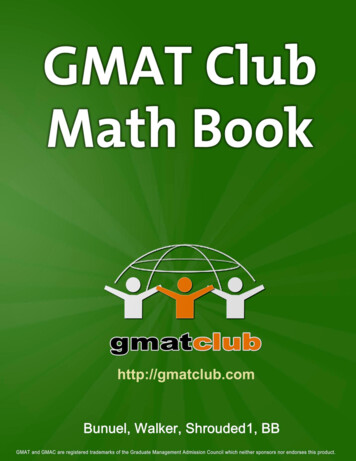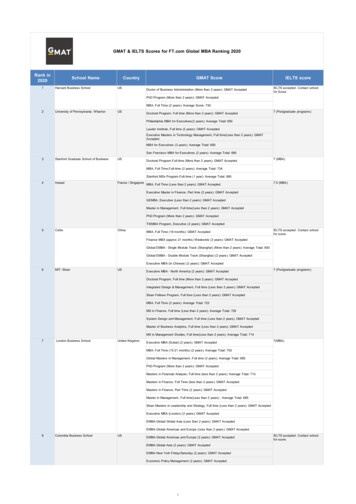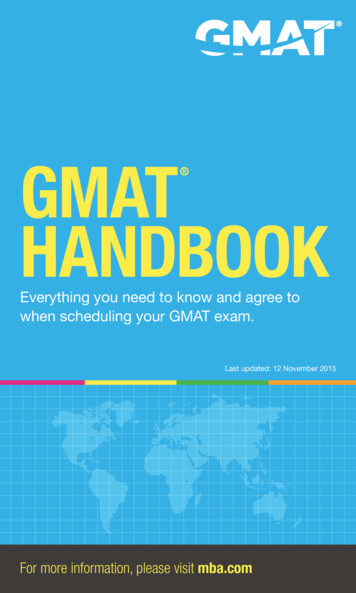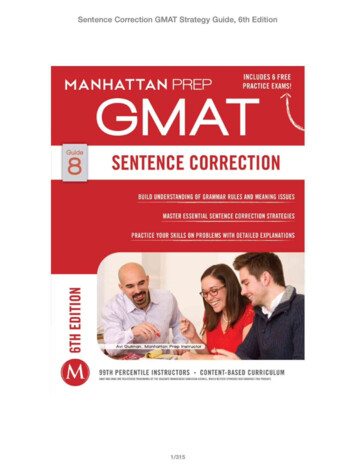
Transcription
Sentence Correction GMAT Strategy Guide, 6th EditionGuide:zC)1-cLI.J:c.co99TH PERCENTILE INSTRUCTORS CONTENT-BASED CURRICULUM1/315
Sentence Correction GMAT Strategy Guide, 6th EditionMANHATTAN PREPGMAT Strategy GuideThis essential guide takes the guesswork out of grammar by presentingall of the major grammatical principles and minor grammatical pointsknown to be tested on the GMAT. Do not be caught relying only on yourear; master the rules for correcting every GMAT sentence.2/315
Sentence Correction GMAT Strategy Guide, 6th Edition3/315
Sentence Correction GMAT Strategy Guide, 6th EditionSentence Correction GMAT Strategy Guide, Sixth Edition10-digit International Standard Book Number: 1-941234-07-013-digit International Standard Book Number: 978-1-941234-07-5eiSBN: 978-1-941234-28-0Copyright 2014 MG Prep, Inc.ALL RIGHTS RESERVED. No part of this work may be reproduced or used in any form or by any meansgraphic, electronic, or mechanical, including photocopying, recording, taping, or web distribution-withoutthe prior written permission of the publisher, MG Prep, Inc.Note: GMAT, Graduate Management Admission Test, Graduate Management Admission Council, and GMACare all registered trademarks of the Graduate Management Admission Council, which neither sponsors noris affiliated in any way with this product.Layout Design: Dan McNaney and Cathy HuangCover Design: Dan McNaney and Frank CallaghanCover Photography: Alli Ugosoli4/315
Sentence Correction GMAT Strategy Guide, 6th EditionINSTRUCTIONAL GUIDE SERIES0GMAT Roadmap(ISBN: 978-1-941234-09-9)Fractions, Decimals, & Percents5Number Properties6Critical Reasoning7Reading Comprehension(ISBN: 978-1-941234-05-1)(ISBN: 978-1-941234 -01-3)(ISBN : 978-1-941234-02-0)2Algebra(ISBN: 978-1-941234 -00-6)Word Problems(ISBN : 978-1-941234-06-8)Sentence Correction5/315
Sentence Correction GMAT Strategy Guide, 6th Edition3(ISBN: 978-1-941234-08-2)4Geometry(ISBN: 978-1-941234-03-7)8(ISBN: 978-1-941234-07-5)9Integrated Reasoning & Essay(ISBN: 978-1-941234-04-4)SUPPLEMENTAL GUIDE SERIESMath GMAT SUP-P-lement GuidesVerbal GMAT SUP-P-lementGuidesFoundations of GMAT MathFoundations of GMAT Verbal(ISBN: 978-1-935707-59-2)(ISBN: 978-1-935707-01-9)Advanced GMAT Quant(ISBN: 978-1-935707-15-8)Official Guide Companion forSentence CorrectionOfficial Guide Companion(ISBN: 978-1-937707-41-5)(ISBN: 978-0-984178-01-8)6/315
Sentence Correction GMAT Strategy Guide, 6th EditionMANHATTANPREPDecember 2, 2014Dear Student,Thank you for picking up a copy of Sentence Correction. I hope this book gives you just theguidance you need to get the most out of your GMAT studies.A great number of people were involved in the creation of the book you are holding. Firstand foremost is Zeke Vanderhoek, the founder of Manhattan Prep. Zeke was a lone tutor inNew York City when he started the company in 2000. Now, well over a decade later, thecompany contributes to the successes of thousands of students around the globe everyyear.Our Manhattan Prep Strategy Guides are based on the continuing experiences of our instructors and students. The overall vision of the sixth edition of the GMAT guides was developed by Stacey Koprince, Whitney Garner, and Dave Mahler over the course of manymonths; Stacey and Dave then led the execution of that vision as the primary author andeditor, respectively, of this book. Numerous other instructors made contributions large andsmall, but I'd like to send particular thanks to josh Braslow, Kim Cabot, Dmitry Farber, RonPurewal, Emily Meredith Sledge, and Ryan Starr. Dan McNaney and Cathy Huang provideddesign and layout expertise as Dan managed book production, while Liz Krisher made surethat all the moving pieces, both inside and outside of our company, came together at justthe right time. Finally, we are indebted to all of the Manhattan Prep students who have given us feedback over the years. This book wouldn't be half of what it is without your voice.7/315
Sentence Correction GMAT Strategy Guide, 6th EditionAt Manhattan Prep, we aspire to provide the best instructors and resources possible, and wehope that you will find our commitment manifest in this book. We strive to keep our booksfree of errors, but if you think we've goofed, please post to manhattanprep.com/GMAT/errata . If you have any questions or comments in general, please email our Student Servicesteam at gmat@manhattanprep.com. Or give us a shout at 212-721-7400 (or 800-576-4628 inthe United States or Canada). I look forward to hearing from you.Thanks again, and best of luck preparing for the GMAT!Sincerely,Chris RyanVice President of AcademicsManhattan Prepwww.manhattanprep.com/gmat 138 West 25th Street, 7th Floor, New York, NY 10001 Tel:212-721-7400 Fax: 646-514-74258/315
Sentence Correction GMAT Strategy Guide, 6th EditionHOW TO ACCESS YOUR ONLINE RESOURCESIF YOU ARE A REGISTERED MANHATTAN PREP STUDENTand have received this boot as part of your course matetlals, you have AUTOMATIC access to ALL of our onlineresources. Thts includes all practtce exams, question banks, and ooline updates to this book. To access thesetesources, foliO\v the instructions in t Welcome Guide ptovlded to you at the start of your prosram.Do NOT follow the lnstrucHons below.IF YOU PURCHASED THIS BOOK FROM MANHATTANPREP.COMOR AT ONE OF OUR CENTERS1. Go to; www.manhattanprep.com/purt/studentcenter2. Log in with the usemame and password you chose when setting up your accountIF YOU PURCHASED THIS BOOK AT ARETAIL LOCATION1. Go to; www.manhattanprep.comlgmatlacceu2. Create an account or, if you already have one. log in on this page with your usemame and password.3. Follow the msttuctions on the screen.Your ooe year of online access begins on the day that you register your book at the above URL.You only need to register your product ONCE at the above URl. To use your online resources any time AfTER you have completed the reg stration process, log in io the following URL:www. manhatta nprep.co mtamat/ttudentc e11terPlease note lhat online access Is nonltansferable. This meal'\5 tnat only NEW and UNREGISTERED copies of the bOOkwill grant you online access. Previously used books will NOT provtde any online resources.IF YOU PURCHASED AN EBOOK VERSION OF TillS BOOK1. Create an account with Manhattan Prep at this website:www.manhattanprep. t oml(mat/re(l ster2. Email a copy of your purchase receipt to amatOmanhattanprep.com to activateyour resources. Please be sure to use t:he same email address to create an acccunt that you used to purchase the eBook.email &lllatOlunhattanprep.cofll Of call 800·S76 4628.Please refer to the tollowmg page tor a descnption of the online resources that come w1thFor any questions,9/315this b x*.
Sentence Correction GMAT Strategy Guide, 6th EditionYOUR ONLINE RESOURCESYOUR PURCHASE INCLUDES ONLINE ACCESS TO THE FOLLOWING:6 FULL-LENGTH GMAT PRACTICE EXAMSThe 6 full-length GMAT practice exams included with the purchase of this book aredelivered online using Manhattan Prep's proprietary computer-adaptivetestengine.1The exams adapt to your ability level by drawing from a bank of more than 1,200 unique23questtons of varymg difficulty levels written by Manhattan Prep's expert mstructors, all ofwhom have scored in the 99th pcroentile on the Official GMAT. At the end of each examyou will recel.ve a score, an analysis of your results, and the opportunity to review detailedexplanations for each question. You may choose to take the exams timed or unt1med.Important Note: The 6 GMAT exams Included with the purch86e of this book are the SAME exams that u receive uponpurch8slng ANY book in the Manhattan Prep GMAT Completestmtegy Guide Set.5 FREE INTERACT LESSONSI nteraotTM Is a comprehensive self-study program that Is fun, Intuitive, and directed by you. Each Interactive video lesson Istaught by an expert Manhattan Prep Instructor and Includes dozens of Individual branching points. The choices you makedefine the content you see. Tnis book comes with access to the first fiVe le.ssons of GMAT Interact. Lessons are available onyour computer or IPad so you can prep where you are, when you want For more Information on the full version of thisprogram, visit llanbattanprep.comlrmallinteraclSENTENCE CORRECTION ONLINE QUESTION BANKThe Online Question Bank for Sentence Correction consists of 25 extra practice questions (with detailed explanations) thattest the variety of concepts and skills covered In this book. These questions provide you with extra practice beyond theproblem sets contained In this book. You may use our onl ine timer to practice your pacing by setting time limits for eachquestion In the bank.ONLINE UPDATES TO THE CONTE.NT IN THIS BOOKThe conte11t presented in this book is updated periodically to ensure that i trenects the GMAT's most current trends.You may view all updates, Including any known errors or changes, upon registering for online access.Tile above resources can be fond i1 your Student Celler at &nanhattanprep.eomf&JnaVst tcenter10/315
Sentence Correction GMAT Strategy Guide, 6th EditionTABLE o CONTENTSOfficial Guide Problem Sets1. The SC Process2. Grammar & MeaningProblem Set3. Sentence StructureProblem Set4. ModifiersProblem Set5. ParallelismProblem Set6. ComparisonsProblem Set7. PronounsProblem Set8. VerbsProblem Set9. IdiomsProblem Set11/315
Sentence Correction GMAT Strategy Guide, 6th Edition10. Meaning, Structure, & Modifiers: ExtraProblem Set11. Parallelism & Comparisons: ExtraProblem Set12. Pronouns & Verbs: ExtraProblem SetAppendix A: IdiomsAppendix B: Glossary12/315
Sentence Correction GMAT Strategy Guide, 6th EditionOfficial Guide Problem SetsAs you work through this Strategy Guide, it is a very good idea to test your skillsusing official problems that appeared on the real GMAT in the past. To help youwith this step of your studies, we have classified all of the problems from thethree main Official Guide books and devised some problem sets to accompanythis book.These problem sets live in your Manhattan GMAT Student Center so that theycan be updated whenever the test makers update their books. When you log into your Student Center, click on the link for the Official Guide Problem Sets,found on your home page. Download them today!The problem sets consist of four broad groups of questions:1. A mid-term quiz: Take this quiz after completing Chapter 4 of thisguide.2. A final quiz: Take this quiz after completing this entire guide.3. A full practice set of questions: If you are taking one of our classes,this is the homework given on your syllabus, so just follow the syllabus assignments. If you are not taking one of our classes, you cando this practice set whenever you feel that you have a very solid understanding of the material taught in this guide.4. A full reference list of all Official Guide problems that test the topicscovered in this Strategy Guide: Use these problems to test yourselfon specific topics or to create larger sets of mixed questions.As you begin studying, try one problem at a time and review it thoroughly before moving on. In the middle of your studies, attempt some mixed sets of problems from a small pool of topics (the two quizzes we've devised for you are good13/315
Sentence Correction GMAT Strategy Guide, 6th Editionexamples of how to do this). Later in your studies, mix topics from multipleguides and include some questions that you've chosen randomly out of the Offi-cial Guide. This way, you'lllearn to be prepared for anything!Study Tips:1. DO time yourself when answering questions.2. DO cut yourself off and make a guess if a question is taking too long.You can try it again later without a time limit, but first practice thebehavior you want to exhibit on the real test: let go and move on.3. DON'T answer all of the Official Guide questions by topic or chapterat once. The real test will toss topics at you in random order, andhalf of the battle is figuring out what each new question is testing.Set yourself up to learn this when doing practice sets.14/315
Sentence Correction GMAT Strategy Guide, 6th EditionChapter10Sentence CorrectionThe SC Process15/315
Sentence Correction GMAT Strategy Guide, 6th EditionIn This Chapter.Question FormatThe SC Process"Best" Does Not Mean IdealSC TimingUsing This BookHow to Get Better at the SC Process16/315
Sentence Correction GMAT Strategy Guide, 6th EditionChapter 1The SC ProcessSentence Correction (SC) is one of three question types found in the Verbal section of theGMAT. Sentence Correction tests your mastery of both grammar and meaning as it appliesto conventional written English.SC questions typically comprise a bit more than one-third of the questions in the Verbal section, so a strong performance on SC is an important part of a great score.Question FormatTake a look at this SC problem :Although William Pereira first gained national recognition for his movieset designs, including those for Rea12 the Wild Wind and Jane Ey.rg, futuregenerations remember him as the architect of the Transamerica Tower,the Malibu campus of Pepperdine University, and the city of Irvine.(A) including those for Reap the Wild Wind and jane Eyre, future generations remember(B)like that for Reap the Wild Wind and jane Eyre, future generations will remember(C)like those for Reap the Wild Wind and jane Eyre, future generations remem-17/315
Sentence Correction GMAT Strategy Guide, 6th Editionbe red(D) including that for Reap the Wild Wind and jane Eyre, future generations remembered(E)including those for Reap the Wild Wind and jane Eyre, future generations willrememberThe question consists of a given sentence, part of which is underlined. The underlined segment may be short, or it may include most or even all of the original sentence. The five answer choices are possible replacements for the underlined segment.In all SC questions, choice (A) is exactly the same as the underlined portion of the sentenceabove it; in other words, you would choose choice (A) if you think nothing is wrong with theoriginal sentence. The other four choices will always offer different options. Your task is tochoose the answer that, when placed in the given sentence, is the best option of those given, in terms of grammar and meaning.By the way, the original sentence, choice (A), is the correct answer just as often as the otheranswer choices-about 20% of the time.The SC ProcessBecause the other two Verbal question types, Critical Reasoning (CR) and Reading Comprehension (RC), require so much reading, you're going to have to move quickly on SC. In fact,you 'Ll need to average just 1 minute and 20 seconds per SC question.As a result, you'Ll need a standard process to help you work through any SC question efficiently and effectively.Here's the basic process:18/315
Sentence Correction GMAT Strategy Guide, 6th Edition123Take a first glance.A.B'Read for meaning.Keep Qtrack! DFind a starting point."Can I tackle this?"YES NO IgnoreEliminate4.E'(ALL incorrect choices) Findanew' m I done?"' , NOstarting point.Choose&YES move on!Try the process out with the William Pereira example:Although William Pereira first gained national recognition for his movieset designs, including those for ReaP- the Wild Wind and Jane Eyre, futuregenerations remember him as the architect of the Transamerica Tower,the Malibu campus of Pepperdine University, and the city of Irvine.(A) including those for Reap the Wild Wind and jane Eyre, future generations remember(B) like that for Reap the Wild Wind and jane Eyre, future generations will remember(C) like those for Reap the Wild Wind and jane Eyre, future generations remembered(D) including that for Reap the Wild Wind and jane Eyre, future generations remembered(E)including those for Reap the Wild Wind and jane Eyre, future generations willremember19/315
Sentence Correction GMAT Strategy Guide, 6th EditionStep 1: Take a first glance.Take a first glance to spot clues that may help you answer the question. (You may not noticemuch at first; you'll get better with practice!)Don't read-just glance briefly at the entire problem. How long is the underline? What'shappening where the underline starts?In the Pereira problem, the underline is relatively short. It begins right after a comma andthe first word is including.The first word of the five answers will always contain at least one difference, so glance downthe first word of each choice. The "split," or difference among the answers, here is includingvs.like.The word including is used to introduce examples. The word like is used to indicate a similarity between two or more things. Keep these in mind as you move to your next step.Step 2: Read the sentence for meaning.While you read the sentence, keep an eye out for both grammar and meaning issues. The object of this step emphasizes meaning because many people forget to think about what thesentence is trying to say.A sentence can be grammatically correct and yet illogical or ambiguous:Anne and Millie went to the movies in her car.Wait a minute .whose car did they take? Anne's? Millie's? Someone else's? The sentence isunclear.What does the William Pereira sentence say?The sentence begins with a contrast word (although), so make sure the rest of the sentencedoes convey a contrast. Although he gained recognition for one thing, he was rememberedfor other, quite different things. That basic meaning does make sense.20/315
Sentence Correction GMAT Strategy Guide, 6th EditionStep 3: Find a starting point.Most SC problems test multiple issues and those issues can appear anywhere in the sentence. Where do you start?Initially, you're likely to have one of two starting points:1. You spot an error {or suspected error) in the original sentence.2. You notice splits, or differences, in the answers.If you think you've found an issue in the original sentence, immediately look through the answers to make sure you're offered at least one split for that issue. If all five are identical,then you haven't actually found an error. If you are offered splits, go ahead and tackle that ISSUe.You might get to the end of the original sentence without spotting an error. In this case,start comparing the answers to find splits. If you don't know how to decide about a particular split, ignore it and find another.The first two steps-first glance and read for meaning-will usually help you to find yourfirst starting point. For instance, in the Pereira problem, the first glance showed a split between including and like, so as you read, ask yourself: why does the sentence mention thesetwo films? They represent examples of Pereira's movie set designs, and examples should beintroduced using the word including, not the word like.Step 4: Eliminate all incorrect choices.AS'Scan down the options. Answers {B) and {C) both use like; eliminate them. DE21/315
Sentence Correction GMAT Strategy Guide, 6th EditionRepeat!There are still three choices left, so find another starting point and repeat steps 3 and 4. After a repetition or two, you'll either get down to one answer or get stuck. Either way, pick ananswer and move on to the next problem.If you spot a difference but don't know how to deal with it, ignore that difference and lookfor some other difference instead.Now, where are you going to find these new starting points? You have two main options:1. Tackle errors that you spotted in the original sentence.2. Compare the remaining answer choices vertically, looking for differences, orsplits. If you know how to tackle a particular split, do so!In the Pereira example, you might note that the answers split on that vs. those. What is atthe heart of that difference?AThe two words are pronouns, but one is singular and one is plural. The pronoun isintended to refer back to the plural word designs, so the singular that is incorrect.Eliminate answer (D).zf22ENow, compare the last two answers, (A) and (E). The only difference is at the end: remembervs. will remember. Pereira first gained recognition for one thing, but the author postulatesthat future generations are going to remember him for something else. The future tense, willremember, fits that meaning.22/315
Sentence Correction GMAT Strategy Guide, 6th Edition]:(Eliminate (A) and pick (E).B'J2BrE" ''Best'' Does Not Mean IdealSentence Correction questions ask for the best option among those given, not the best option in the universe. Sometimes you may feel-and rightly so-that all the answers, including the correct one, aren't very good. Correct GMAT Sentence Correction answers neverbreak strict grammatical rules, but these answers can sound formal or even awkward. Expect that, at times, a correct answer won't sound or feel very good to you.SC TimingIn order to have adequate time for RC and CR questions, you'll need to average about 1minute and 20 seconds per SC problem.How can you possibly move that quickly and still get the right answer? Here's how: Most wrong answers contain more than one error; you only need one valid reasonto cross off any wrong answer. The same error is often repeated in two or more choices. The SC process described earlier capitalizes on the first two points above to getyou through the problem as efficiently as possible.In general, try to spend at least 40 seconds on any SC question; if you work more quicklythan that, you are more likely to make careless mistakes. Speed is never an advantage if itcauses you to miss problems that you know how to answer.23/315
Sentence Correction GMAT Strategy Guide, 6th EditionIf you're approaching the two-minute mark, wrap the problem up. If you need that long toanswer, chances are good that you're missing something or have already made a mistake.Don't cross the two-minute mark on SC; instead, guess from among the remaining answersand move on.Using This BookComplete the chapters in the order in which they are presented, because later materialsometimes builds on material presented earlier in the book.At the end of this chapter, you'll find a section called How to Get Better at the SC Process.Every chapter or two, return to the How to Get Better section and do some drills to honeyour skills on the various steps of the process.When answering practice questions, if you are completely confident that an answer iswrong even though you can't articulate exactly why, go ahead and cross that answer off.When you are reviewing your work afterwards, check to make sure that you were correct. Ifso, you may be able to trust your "ear" for that type of error in future.If not, however, then you will need to dive into the grammar or meaning issues, possibly including learning some technical grammar terminology and rules, so that you can retrainyour ear for future problems.The first two chapters of this guide cover strategy and overall lessons for SC, while the subsequent chapters teach specific grammar and meaning concepts that you need to know forthe GMAT.Beginning with Chapter 2, you will have problem sets on which to test your skills. Try abouthalf of the problems included in the end-of-chapter set; save the rest for future study. Afteryou complete each problem, check the answer. Whenever necessary, return to the lessons inthe chapter to solidify your understanding before trying the next problem.You also have online access to problem set lists that refer to questions found in the threeOfficial Guide books published by the test makers. If you have access to these other books,then you can use our problem set lists in your practice.24/315
Sentence Correction GMAT Strategy Guide, 6th EditionHow to Get Better at the SC ProcessFirst GlanceYour first glance at a problem is, by definition, quick and superficial, but-if you get good atthis step-you can pick up some very useful clues that will help you read the original sentence with an idea already in mind of what the sentence may be testing.For SC, pay attention to three issues during your first glance:Possible ImplicationClue1. Is the underline very Very long underlines often signal issues with sentence struc-long? Very short?ture, meaning, modifiers, and parallelism.Very short underlines (less than five words) may lead you tocompare the answers in full before reading the original sentence.2. What is the first un- The nature of the first underlined word (or the word just bederlined word? What fore) can give you a clue about one of the issues tested in theis the word right be- sentence. For example, if the word has is the first underlinedfore?word, the sentence is likely testing either subject-verb agreement or verb tense, since has is a verb.3. What are the differ- There will always be at least one difference at the beginning ofences among the first the answers (as well as one at the end). It's easy to glanceword or two of each down the first word or two of each answer, so do so. If theanswer?first word switches between has and have, for example, thenyou know the sentence is testing singular vs. plural. Now, youcan actively look for the relevant subject when you read theoriginal sentence.After you 've studied SC for a few weeks and tried some problems from any of the three Official Guide books published by the test makers, you can add a first glance drill to your studyregimen . Find some lower-numbered (easier) problems that you've already tried in the past.25/315
Sentence Correction GMAT Strategy Guide, 6th EditionGive yourself a few seconds (no more than five!) to glance at a problem, then look away andsay out loud what you noticed in those few seconds.Afterwards, look at the full problem and remind yourself what it tests. Did your first glanceunearth any of those issues? Examine the first underlined word, the one just before, and thefirst words of each choice more carefully, and ask yourself whether there are any clues, ormarkers, you missed . If so, write them down on a flash card. Here's an example:(back}(front)I'll think:When I see:dLSometimes, there are no good clues at the first glance level, so don't expect that this strategy will always help you. Still, don't skip this step; good clues exist for more than 50% ofproblems, so this quick step is quite valuable.Read the Sentence for MeaningYour default strategy is to read the entire original sentence, all the way to the period, notingpossible grammar or meaning issues along the way. The non-underlined portion containsvery valuable information that can help you decide how to proceed . Once you're done, decide which issue to tackle first. If you think you've spotted an error in the original, verify,then cross off answer (A) as well as any other answers that repeat that same error.You might, though, choose to break this strategy for one very good reason : you spot an earlyerror in a longer underline and you are 100% sure that you 've found a definite error. In thatcase, go ahead and eliminate choice (A) immediately and glance through the remaining answers to eliminate any with that same error. At that point, though, return to the originalsentence and finish reading it, keeping an eye out for any additional errors that you coulduse to eliminate other answers.26/315
Sentence Correction GMAT Strategy Guide, 6th EditionEither way, read the entire original sentence so that you can spot overall issues with meaning or sentence structure. If you don't, you'll be much more likely to fall into a trap.To drill yourself on meaning, pull out your Official Guide again and look at some problemsyou 've done in the past. Read only the original sentence (not the answers), then look awayand try to articulate aloud, in your own words, what the sentence is trying to say. (You don'tneed to limit your rephrase to a single sentence.)Do actually talk out loud. You'll be able to hear the conviction in your own voice when youknow what the sentence is trying to say and you'll also know if you don 't really know whatthe sentence means.In the latter case, examine the problem again. Either you just didn't understand it or therewas actually a meaning issue in that sentence. Which is it? Check the solution: does it saythat there is a meaning problem? If so, then great-no wonder you had trouble rephrasingit. If not, then the explanation itself may help you to understand what the sentence is tryingto say. (If you don't like the official solution, you can find many Official Guide solutions inour GMAT Navigator program .)Find a Starting PointMost of the time, you'll have to find multiple starting points on SC problems-one of the annoying things about this problem type. There are two primary ways to find a starting point:read the original sentence and compare answers.To drill the latter skill, open up your Official Guide again and look at some problems youhave done before. This time, do NOT read the original sentence. Instead, cover it up.Compare the answers and, based on the splits that you spot, try to articulate all of thethings that the problem is testing.You usually won't be able to pick an answer, but you can often tell what is being tested evenwhen you can't tell how to answer. For example, you might see a verb switching back andforth between singular and plural. If the subject isn't underlined, then you can't know whichverb form is required (because you haven't read the sentence!), but you do know that subject-verb agreement is an issue.When you're done, read the underlined portion of the sentence or check the solution. How27/315
Sentence Correction GMAT Strategy Guide, 6th Editiongood were you at figuring out what the problem was testing? What clues did you miss? Consider making flash cards for those clues.Eliminate All Incorrect ChoicesOne of the most annoying moments in SC occurs when you've narrowed the answers downto two . and then you don't know how to decide. When this happens to you, don't wastetime going back and forth repeatedly, agonizing over the answers. Pick one of the two andmove on.Afterward, review the problem and learn how to make that choice. A
Sentence Correction GMAT Strategy Guide, 6th Edition MANHATTAN PREP December 2, 2014 Dear Student, Thank you for picking up a copy of Sentence Correction. I hope this book gives you just the guidance you need to get the most out of your GMAT studies. A great number of people were involved in the creation of the book you are holding. First

